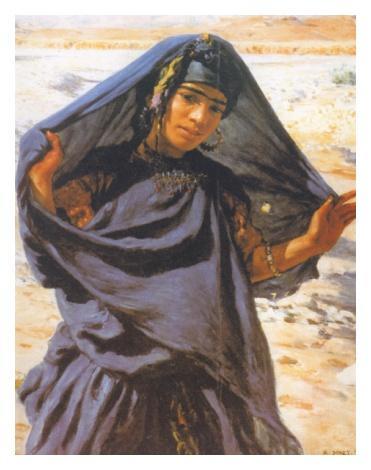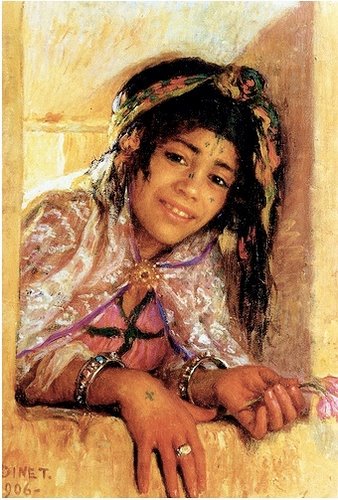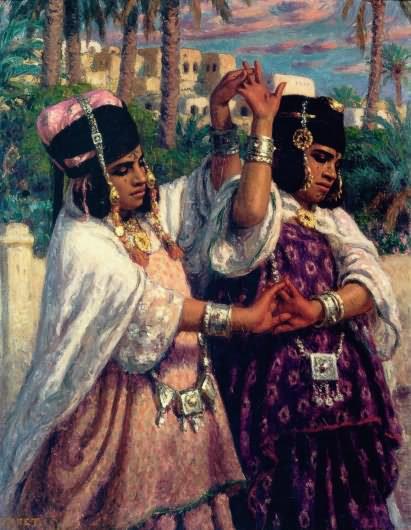Etienne(Nasreddine) Dinet French(1865 -1930
Nasreddine Dinet From Wikipedia, the free encyclopedia Nasreddine Dinet (born as Alphonse-Étienne Dinet on March 28, 1861 - December 24, 1929, Paris) was a French orientalist painter. Biography Dinet was born the son of a prominent French judge.[1] In 1865 his sister Jeanne, who would be his biographer, was born.[2] From 1871, he studied at the Lycée Henry IV, where the future president Alexandre Millerand was also among the students. Upon graduation in 1881 he enrolled in the École nationale supérieure des Beaux-Arts and entered the studio of Victor Galland. The following year he studied under William Bouguereauand Tony Robert-Fleury at the Académie Julian. He also exhibited for the first time at the Salon des artistes français. Dinet made his first trip to Bou Saâda in southern Algeria in 1884, with a team of entomologists. The following year he made a second trip on a government scholarship, this time to Laghouat.[1] At that time he painted his first two Algerian pictures: les Terrasses de Laghouat and l'Oued M'Sila après l'orage. He won the silver medal for painting at the Exposition Universelle in 1889, and in the same year founded the Société Nationale des Beaux-Arts along with Meissonier, Puvis de Chavannes, Rodin, Carolus-Duran and Charles Cottet. In 1903 he bought a house in Bou Saâda and spent three quarters of each year there.[1] He announced his conversion to Islam in a private letter of 1908, and completed his formal conversion in 1913, upon which he changed his name to Nasr'Eddine Dinet.[3] In 1929 he and his wife undertook the Hajj to Mecca.[3] The respect he earned from the natives of Algeria was reflected by the 5,000 who attended his funeral on 12 January 1930 in Bou Saâda.[3]There he was eulogized by the former Governor General of Algeria Maurice Viollette.[3] Work Compared to modernist painters such as Henri Matisse, who also visited northern Africa in the first decade of the 20th century, Dinet's paintings are extremely conservative. They are highly mimetic, indeed ethnographic, in their treatment of their subject.[4] Dinet's understanding of Arab culture and language set him apart from other orientalist artists. Surprisingly, he was able to find nude models in rural Algeria. Before 1900, most of his works could be characterized as "anecdotal genre scenes".[3] As he became more interested in Islam, he began to paint religious subjects more often.[3] He was active in translating Arabic literature into French, publishing a translation of a 13th century Arab epic poem by Antarah ibn Shaddad in 1898.[5] Citations 1. ^ a b c Benjamin, in Edwards and Wood (2004) p. 88 2. ^ Jeanne Dinet Rollince, La Vie de E. Dinet, GP. Maisonneuve, 1938 3. ^ a b c d e f Benjamin, in Edwards and Wood (2004) p. 89 4. ^ Benjamin, in Edwards and Wood (2004) p. 90 5. ^ Pouillon, Francois (1997) Les deux vies d'Etienne Dinet, peintre en Islam: L'Algerie et l'heritage colonial Editions Balland, Paris References Benjamin, Roger (2004). "Chapter 3: Orientalism, modernism and indigenous identity". In Edwards, Steve; Wood, Paul. Art of the Avant-Gardes. New Haven: Yale University Press in association with The Open University. ISBN 0300102305. François Pouillon, Les Deux vies d'Etienne Dinet, Balland, 1997 ISBN 271581142X External links Works by Dinet at Artcyclopedia Detailed time-line of Dinet's life












































































Tidak ada komentar:
Posting Komentar